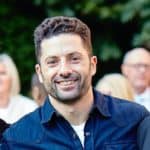- Myth 1: Low Volume
- Myth 2: Not enough Deadlifts
- Myth 3: Low Frequency
- Myth 4: Too much legs
- Myth 5: Low Intensity
- Myth 6: Doesn’t build muscle
- Myth 7: The assistance work is bad
- Myth 8: No individualization
- Myth 8: No individualization
- Myth 9: Workout B isn’t a light day
- Myth 10: Too much volume
- References
Here are 10 popular myths that you’ll hear about Madcow 5×5.
I believed several of these myths when I discovered the 5×5 workout in 2003. Twenty years later, some people are still spreading these myths even though we now have plenty of evidence showing the truth.
Let’s debunk these myths one by one.
Contents
- Myth 1: Madcow 5×5 is low volume
- Myth 2: Not enough Deadlifts
- Myth 3: Madcow 5×5 is low frequency
- Myth 4: Madcow 5×5 is too much legs
- Myth 5: Madcow 5×5 is low intensity
- Myth 6: Madcow 5×5 doesn’t build muscle
- Myth 7: The assistance work is bad
- Myth 8: No individualization
- Myth 9: Workout B isn’t a light day
- Myth 10: Madcow 5×5 is too much volume
- References
Join the Stronglifts community to get free access to all the spreadsheets for every Stronglifts program. You’ll also get daily email tips to stay motivated. Enter your email below to sign up today for free.
Myth 1: Madcow 5×5 is low volume
Some people claim Madcow 5×5 is low volume. They think there aren’t enough sets or exercises for the program to work.
Ralston et al and Schoenfeld et al defined low volume as up to five sets per lift or muscle per week (1, 2). High volume was +10 sets.
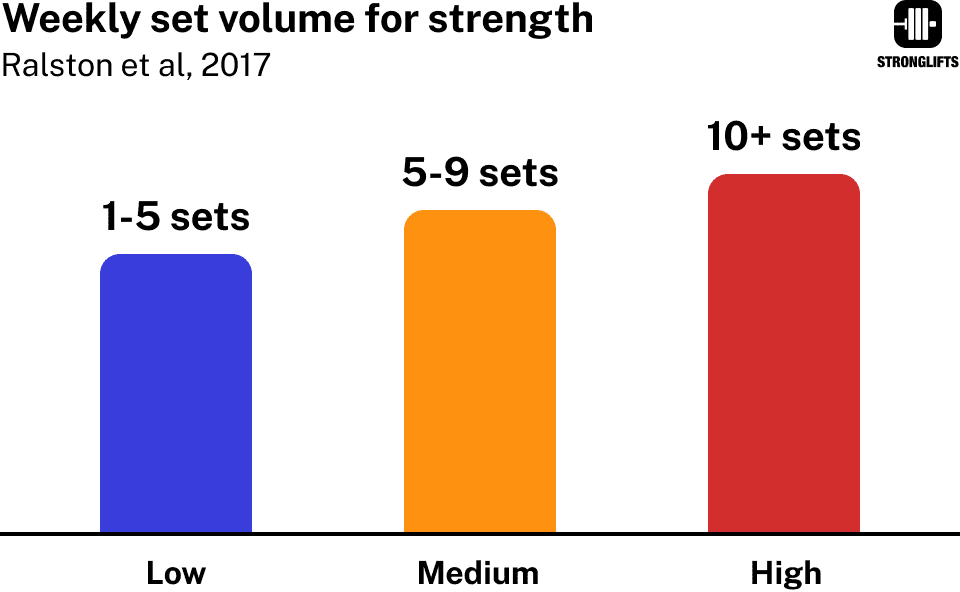
Let’s count the sets on Madcow 5×5. This is the program…
| Workout A | Workout B | Workout C |
|---|---|---|
| Squat 5×5 | Squat 4×5 | Squat 4×5, 1×3, 1×8 |
| Bench 5×5 | Incline Bench 4×5 | Bench 4×5, 1×3, 1×8 |
| Rows 5×5 | Deadlift 4×5 | Rows 4×5, 1×3, 1×8 |
| Assistance | Assistance | Assistance |
If you take the sum of the sets for each exercise, you find that Madcow 5×5 is high volume on every lift except Deadlifts (see myth #2).
| Exercise | Weekly sets | Volume |
|---|---|---|
| Squat | 15 sets | High |
| Bench | 15 sets | High |
| Deadlift | 4 sets | Low |
| Rows | 11 sets | High |
If you count the total weekly sets per muscle group, you also find that Madcow 5×5 is high volume.
| Muscle | Exercise | Sets/week | Volume |
|---|---|---|---|
| Chest | Bench, Incline Bench | 15 | High |
| Shoulders | Incline Bench, Bench | 15 | High |
| Back | Barbell Row, Deadlift | 15 | High |
| Triceps | Bench, Incline Bench | 15 | High |
| Biceps | Barbell Row | 11 | High |
| Legs | Squat, Deadlift | 19 | High |
The usual counter is that only the top sets are hard on Madcow 5×5. But this depends. What’s easy for Paul can be hard for Peter. If it’s too easy for you, you can add volume using smaller set intervals.
| Set intervals | 15% | 10% | 5% |
|---|---|---|---|
| Set 1 | 5×110lb | 5×165lb | 5×220lb |
| Set 2 | 5×150lb | 5×190lb | 5×235lb |
| Set 3 | 5×190lb | 5×220lb | 5×245lb |
| Set 4 | 5×235lb | 5×245lb | 5×260lb |
| Set 5 | 5×275lb | 5×275lb | 5×275lb |
| Volume | 4800lb | 5475lb | 6175lb |
A common mistake is to pyramid the ramp sets by dropping reps as you add weight. This lowers the volume. Keep the reps constant.
| Squat workout A | Pyramid sets | Ramp sets |
|---|---|---|
| Set 1 | 5×135 | 5×135 |
| Set 2 | 3×170 | 5×170 |
| Set 3 | 2×205 | 5×205 |
| Set 4 | 1×240 | 5×240 |
| Set 5 | 5×275 | 5×275 |
| Volume | 3210lb | 5125lb |
If you need more volume, add assistance work. Two extra exercises for Bench can add 40% volume for your chest and triceps.
| Madcow 5×5 Chest volume | Bench, Incline Bench | Bench, DB Bench Incline Bench, CGBP |
|---|---|---|
| Workout A | 5 sets | 8 sets |
| Workout B | 4 sets | 4 sets |
| Workout C | 6 sets | 9 sets |
| Total/week | 15 sets | 21 sets (+40%) |
Another way to count volume is set × rep × weight. Madcow 5×5 has a four week on-ramp. You start light with a lower volume.
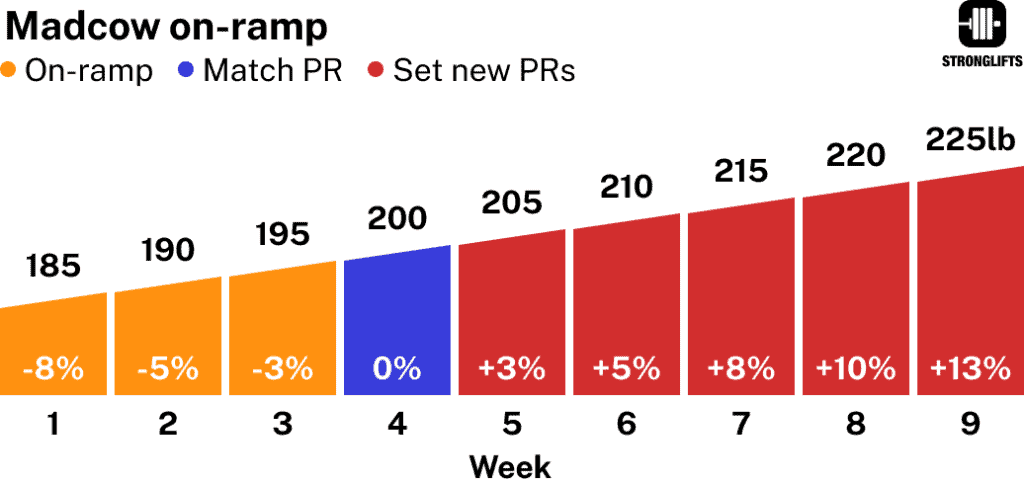
You add weight every week on Madcow 5×5. This increases the volume of each workout over time.
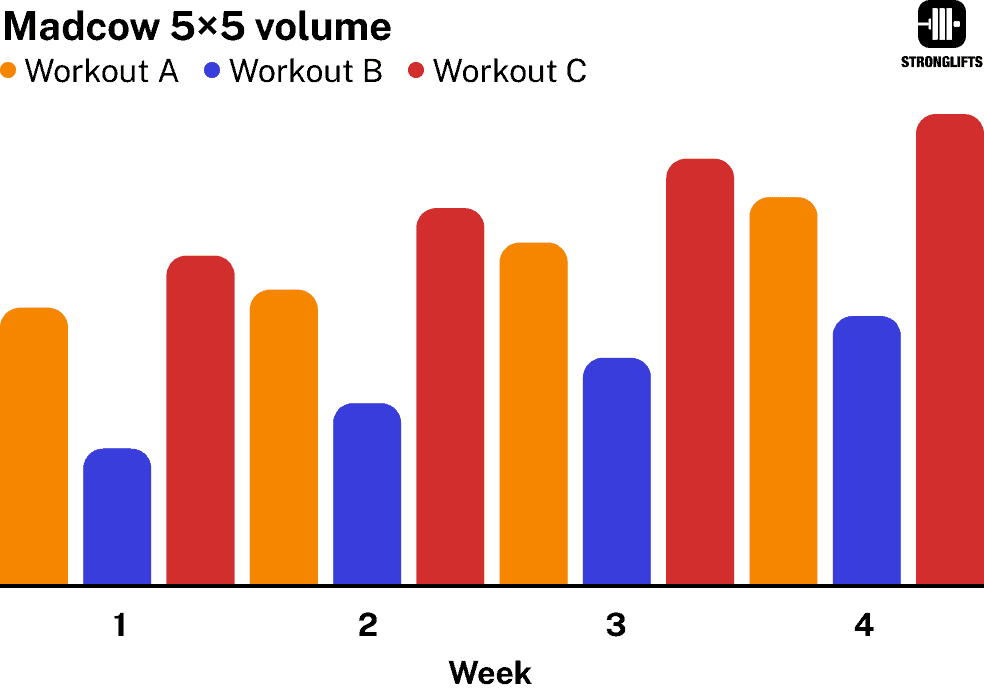
Truth: Madcow 5×5 isn’t low volume. It’s high volume. People who say it’s low volume are either very advanced or don’t realize that the weight increases over time. This adds volume. You can add even more volume using smaller set intervals or extra assistance work.
Myth 2: Not enough Deadlifts
Some people claim Madcow 5×5 doesn’t have enough Deadlifts. They think there’s only one set of five reps per week for Deadlifts, and that Deadlifting once a week is not enough to progress.
You don’t Deadlift one set of five reps per week on Madcow 5×5. You Deadlift four ramp sets of five reps.
| Workout A | Workout B | Workout C |
|---|---|---|
| Squat 5×5 | Squat 4×5 | Squat 4×5, 1×3, 1×8 |
| Bench 5×5 | Incline Bench 4×5 | Bench 4×5, 1×3, 1×8 |
| Rows 5×5 | Deadlift 4×5 | Rows 4×5, 1×3, 1×8 |
Your fourth set is the heaviest of the day. But the first three sets don’t count for nothing. They add volume.
| Deadlift | 1×5 | 4×5 |
|---|---|---|
| Set 1 | 5×315 | 5×195 |
| Set 2 | 5×235 | |
| Set 3 | 5×275 | |
| Set 4 | 5×315 | |
| Volume | 1575lb | 5100lb |
Some people pyramid the ramp sets. This makes the top set easier to Deadlift. But it lowers the volume. Keep the reps constant.
| Ramp sets | Pyramid | Constant |
|---|---|---|
| Set 1 | 5×195 | 5×195 |
| Set 2 | 3×235 | 5×235 |
| Set 3 | 1×275 | 5×275 |
| Set 4 | 5×315 | 5×315 |
| Volume | 3530lb | 5100lb |
If the first three sets are too easy for you, use smaller set intervals. This decreases the weight jumps between sets and adds volume.
| Set intervals | 15% | 5% |
|---|---|---|
| Set 1 | 5×175 | 5×270 |
| Set 2 | 5×220 | 5×285 |
| Set 3 | 5×270 | 5×300 |
| Set 4 | 5×315 | 5×315 |
| Volume | 4900lb | 5850lb |
Is Deadlifting 1x/week enough? You’re not just Deadlifting 1x/week. You’re also Squatting 3x/week. The Squat gains carry over.
| Nigro et al, 2020 | Squat | Deadlift |
|---|---|---|
| Frequency | 3×/week | 0×/week |
| Before | 273lb | 285lb |
| After | 310lb | 304lb |
| Gain | +36lb | +19lb |
A study by Nigro et al had guys Squat 3x/week for six weeks (3). They didn’t Deadlift at all during the study. Yet their Deadlift increased too.
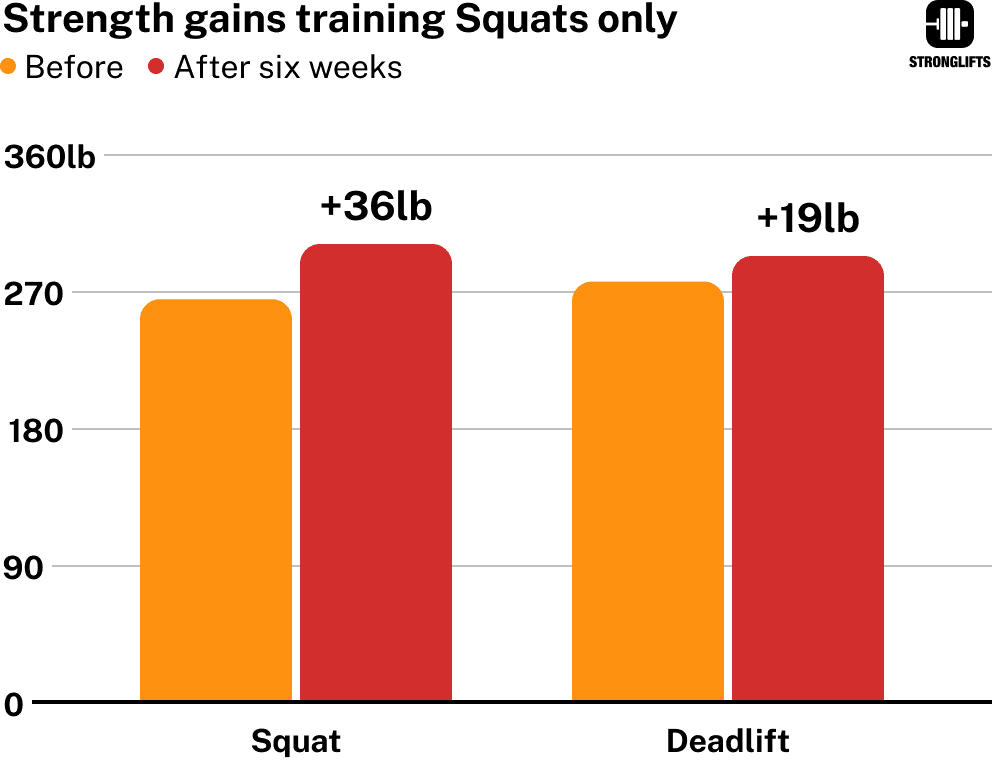
If Squatting 3x/week increases your Deadlift, then Squatting 3x/week and Deadlifting 1x/week definitely increases your Deadlift. It’s typical for powerlifters to do DL 1x/week, SQ 2x/week and BP 3x/week (4).
Why not Deadlift more? 91% of powerlifters in a study said Deadlifts are more taxing (5). They get more sore and require more recovery.

The study by Nigro et al also had 14 guys Deadlift 3x/week (3). Three had back pain within four weeks. No one had back pain Squatting 3x/week.
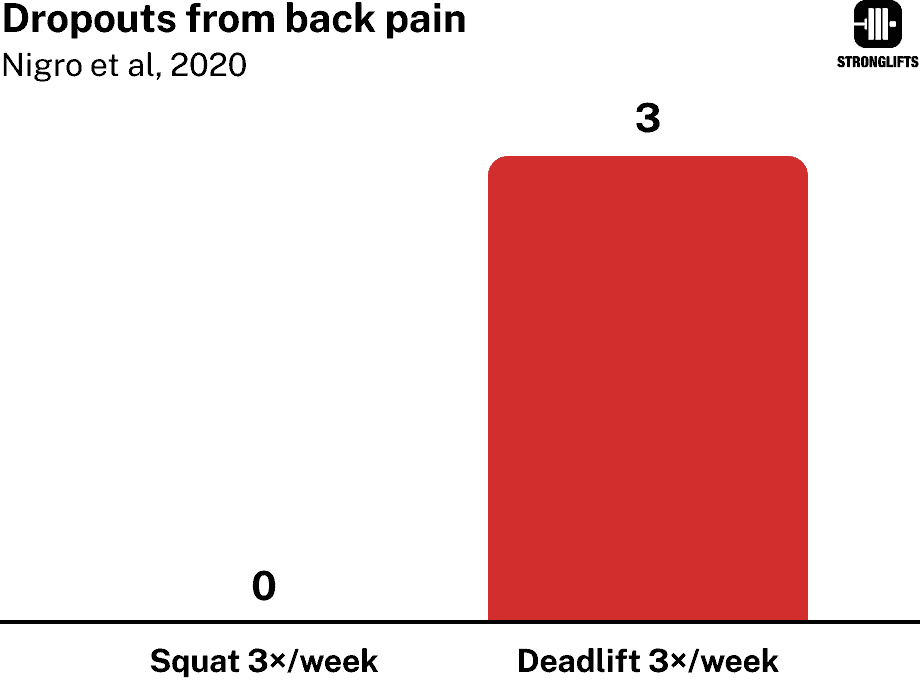
Many lifters can’t handle heavy Deadlifts 2-3x/week (I do). If you can and want more, add Romanian Deadlift to Madcow 5×5. Example…
| Workout A | Workout B | Workout C |
|---|---|---|
| Squat 5×5 | Squat 4×5 | Squat 4×5, 1×3, 1×8 |
| Bench 5×5 | Incline Bench 4×5 | Bench 4×5, 1×3, 1×8 |
| Rows 5×5 | Deadlift 4×5 | Rows 4×5, 1×3, 1×8 |
| CGBP 3×8 | Chinups 3×8 | Romanian DL 3×8 |
More Deadlifts aren’t needed for most people who do Madcow 5×5. Results of Stronglifters show Deadlifts increase. Example:
| Before | After | Gains | |
|---|---|---|---|
| Squat | 200lb | 290lb | +90lb |
| Bench | 195lb | 240lb | +45lb |
| Deadlift | 275lb | 380lb | +105lb |
| Body weight | 175lb | 184lb | +9lb |
Truth: Madcow 5×5 has enough Deadlifts. The strength gains on the Squat carry over to the Deadlift. If you want more volume you can use smaller set intervals or add assistance work.
Read also:
Myth 3: Madcow 5×5 is low frequency
Some people claim Madcow 5×5 is low frequency. They think the program doesn’t have enough frequency to make progress.
Frequency means how many times you train an exercise or muscle per week (6). It can also mean how many workouts per week you do.
Ralston et al categorized three workouts a week as high frequency (7)…
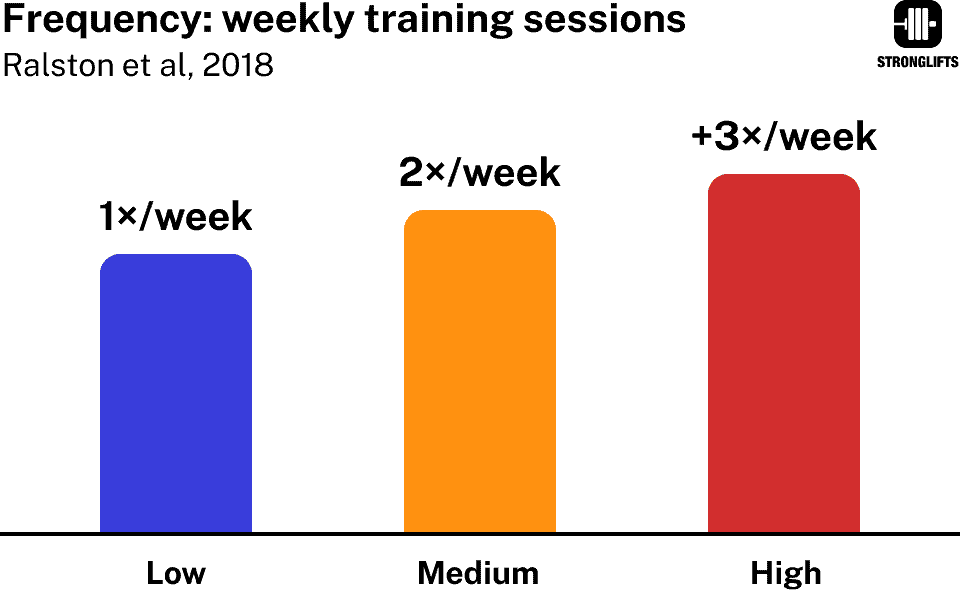
Madcow 5×5 is three workouts a week. That’s high frequency.
Let’s count how many times per week you Squat, Bench, Row and Deadlift on Madcow 5×5. Here’s the math:
| Exercise | Workouts | Frequency |
|---|---|---|
| Squat | 3×/week | High |
| Bench | 3×/week | High |
| Barbell Row | 2×/week | Medium |
| Deadlift | 1×/week | Low |
Madcow 5×5 is high to medium frequency for Squat, Bench and Row. It’s low frequency for Deadlifts only (not an issue, see myth #2).
Let’s count how many times you train each muscle group per week on Madcow 5×5. Here’s the math…
| Muscle | Exercise | Workouts | Frequency |
|---|---|---|---|
| Chest | Bench, Incline Bench | 3×/week | High |
| Shoulders | Incline Bench, Bench | 3×/week | High |
| Back | Barbell Row, Deadlift | 3×/week | High |
| Triceps | Bench, Incline Bench | 3×/week | High |
| Biceps | Barbell Row | 2×/week | Medium |
| Legs | Squat, Deadlift | 3×/week | High |
Madcow 5×5 is high frequency for every muscle but biceps. If you think your biceps needs more, add assistance work.
People who say Madcow 5×5 is low frequency must be lifting 4-6x per week. Yet a study by Schoenfeld et al found that this doesn’t build more muscle than 3x/week when the total weekly volume is the same (8).
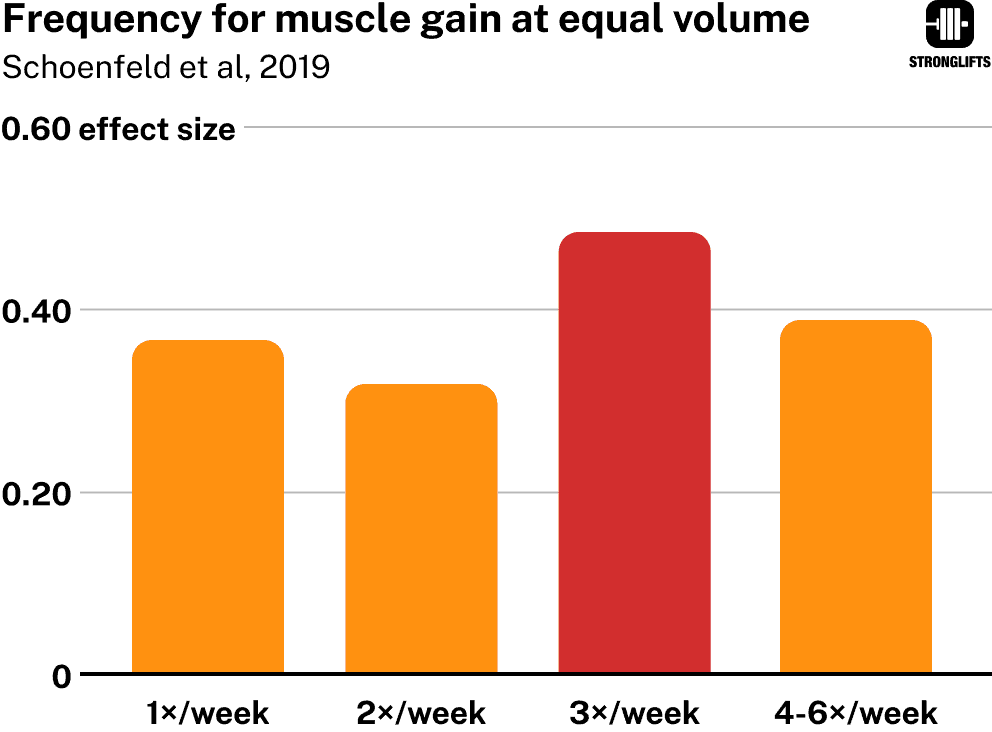
The counter is that high frequency allows you to do more volume. True. But Madcow 5×5 is already high frequency and high volume (myth #1).
The high Squat/Bench frequency of Madcow 5×5 spreads the 15 sets over three workouts. This makes the high volume easier to handle.
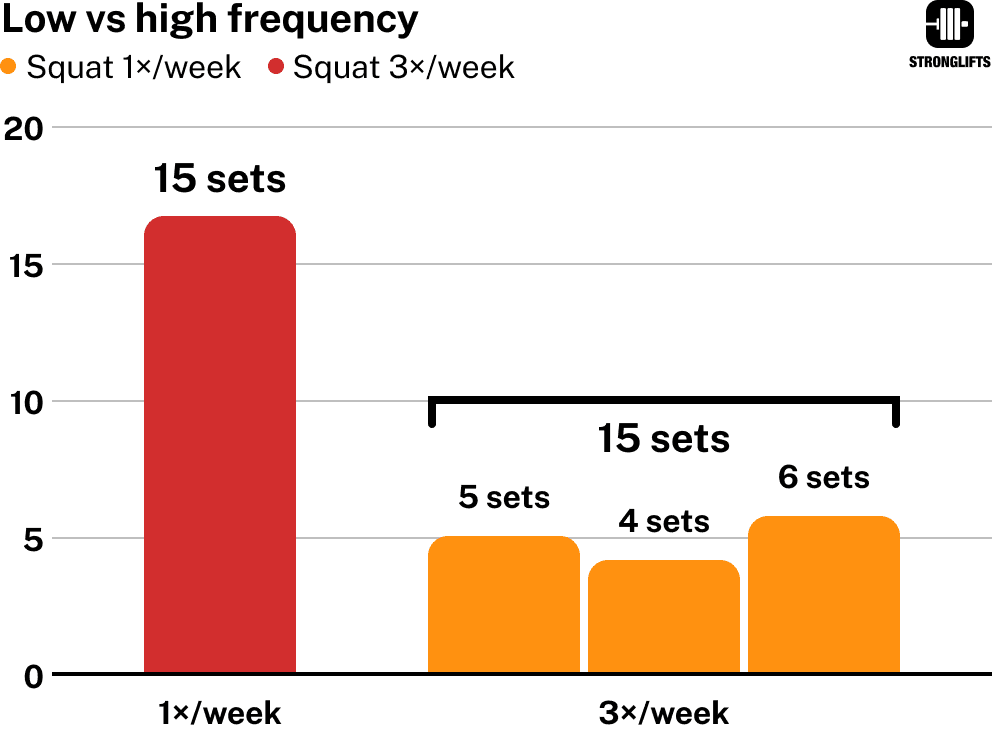
Truth: Madcow 5×5 is high frequency. You do three workouts a week. You Squat and Bench Press 3x/week. You train chest, shoulders, back, legs, triceps 3x/week. All of that is high frequency.
Read also
Myth 4: Madcow 5×5 is too much legs
Some people claim Madcow 5×5 doesn’t have enough work for the upper body. They think there’s too much Squatting and that this will result in too big legs or “T-rex mode” (sic).
You can calculate how much work Madcow 5×5 has for your lower and upper body by counting the weekly sets. Here’s the math:
| Muscle | Lower body | Upper body |
|---|---|---|
| Exercises | Squat, Deadlift | Bench, Incline/OHP, Row |
| Sets/week | 19 | 26 |
| Ratio | 42% | 58% |
Madcow 5×5 has seven more sets per week for your upper body. You work your upper body more despite Squatting every workout.
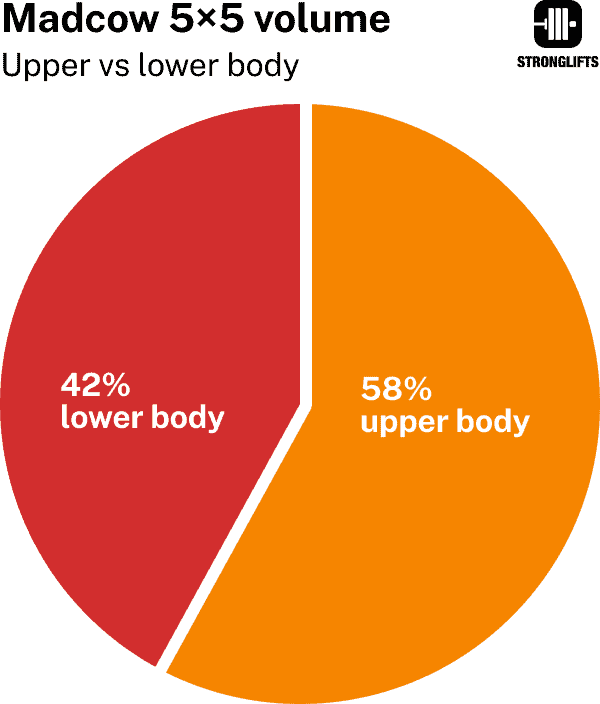
If you think doing 58% work for your upper body is not enough, you can add volume with assistance work. Example…
| Workout A | Workout B | Workout C |
|---|---|---|
| Squat 5×5 | Squat 4×5 | Squat 4×5, 1×3, 1×8 |
| Bench 5×5 | Incline Bench 4×5 | Bench 4×5, 1×3, 1×8 |
| Rows 5×5 | Deadlift 4×5 | Rows 4×5, 1×3, 1×8 |
| CGBP 3×8 | Chinups 3×8 | DB Bench 3×8 |
You’re now doing 16 more sets for your upper than lower body.
| Muscle | Lower body | Upper body |
|---|---|---|
| Exercises | Squat Deadlift | Bench, Incline, Row CGBP, DB Bench, Chinup |
| Sets/week | 19 | 35 |
| Ratio | 35% | 65% |
Only 35% volume goes to your legs. 65% to your upper body.
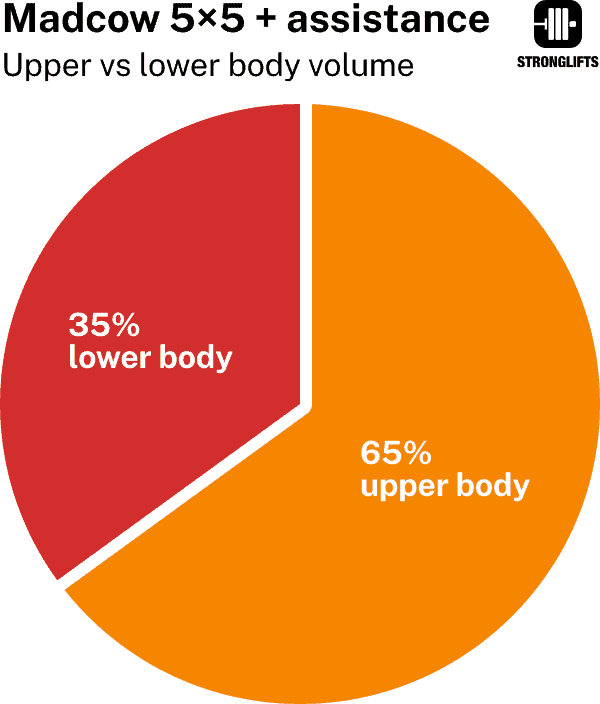
Just watch out you don’t end with chicken legs from focusing too much on the upper body. That’s much more likely than “T-rex mode”.
Truth: Madcow 5×5 has more upper body than lower body work. People who say it’s too much legs didn’t count the sets or don’t like Squats. If 58% work for the upper body is not enough, add assistance work.
Read also:
Myth 5: Madcow 5×5 is low intensity
Some people claim Madcow 5×5 is too low intensity. They think the workouts don’t have enough heavy sets and are too easy.
Madcow 5×5 starts low intensity on purpose. Your body needs to adapt to the volume and frequency first. The four week on-ramp eases you into the program.

You add weight every week. This increases your intensity over time. Your sets become heavier and harder. Your volume increases.
| Squat workout A | Week 1 | Week 2 | Week 12 |
|---|---|---|---|
| Set 1 | 5×135 | 5×140 | 5×165 |
| Set 2 | 5×170 | 5×175 | 5×205 |
| Set 3 | 5×205 | 5×210 | 5×250 |
| Set 4 | 5×240 | 5×245 | 5×290 |
| Set 5 | 5×275 | 5×280 | 5×330 |
| Volume-load | 5125lb | 5250lb | 6200lb |
You can increase the intensity further using smaller set intervals. This decreases the weight jumps between sets.
| Set intervals | 15% | 10% | 5% |
|---|---|---|---|
| Set 1 | 5×110lb | 5×165lb | 5×220lb |
| Set 2 | 5×150lb | 5×190lb | 5×235lb |
| Set 3 | 5×190lb | 5×220lb | 5×245lb |
| Set 4 | 5×235lb | 5×245lb | 5×260lb |
| Set 5 | 5×275lb | 5×275lb | 5×275lb |
| Volume | 4800lb | 5475lb | 6175lb |
With 15% set intervals you do two sets with 235lb or more. With 5% set intervals you do four. This increases your volume by 30%.
| Set intervals | 15% | 5% |
|---|---|---|
| Set 1 | 5×110lb | 5×220lb |
| Set 2 | 5×150lb | 5×235lb |
| Set 3 | 5×190lb | 5×245lb |
| Set 4 | 5×235lb | 5×260lb |
| Set 5 | 5×275lb | 5×275lb |
| Volume | 4800lb | 6175lb |
Truth: Madcow starts low intensity to ease you into the program. The intensity increases every week as you add weight on the bar. You can increase the intensity further using smaller set intervals.
Read also:
Myth 6: Madcow 5×5 doesn’t build muscle
Some people claim Madcow 5×5 doesn’t build muscle. They think you need high reps for hypertrophy and that five reps isn’t “optimal”.
Kubo et al compared sets of 4, 8 and 12 reps. 8 and 4 reps added as much muscle as 12 reps (9). But 12 reps built less strength.
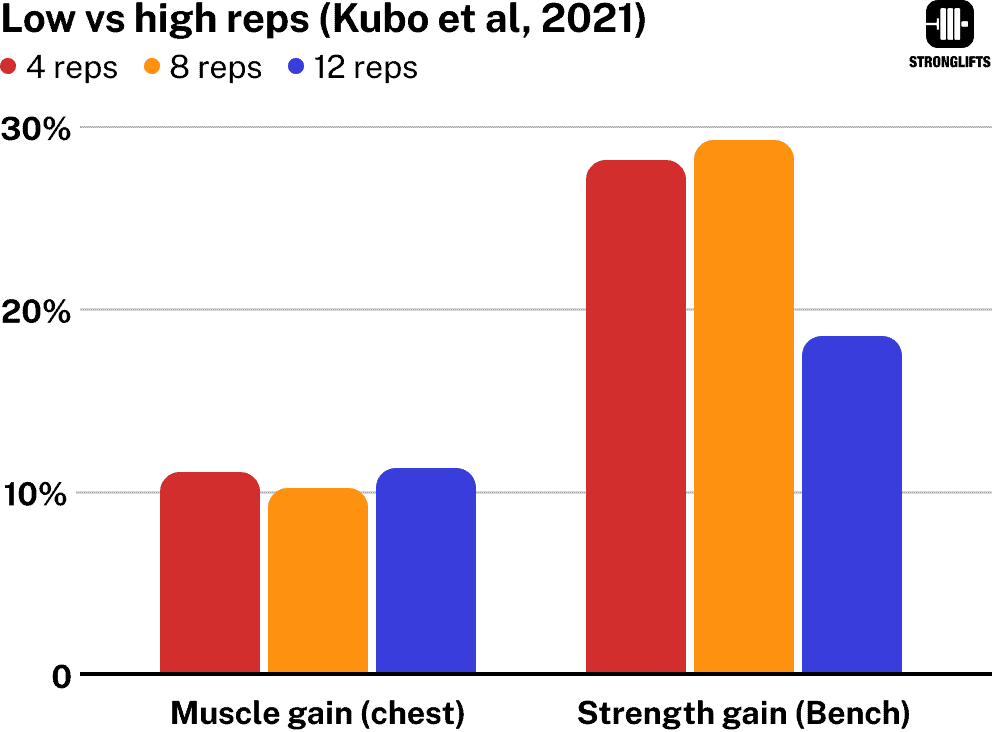
Mangine et al compared 10-12 reps to 3-5 reps (10). 3-5 reps increased lean arm muscle mass and Bench Press 1RM more.
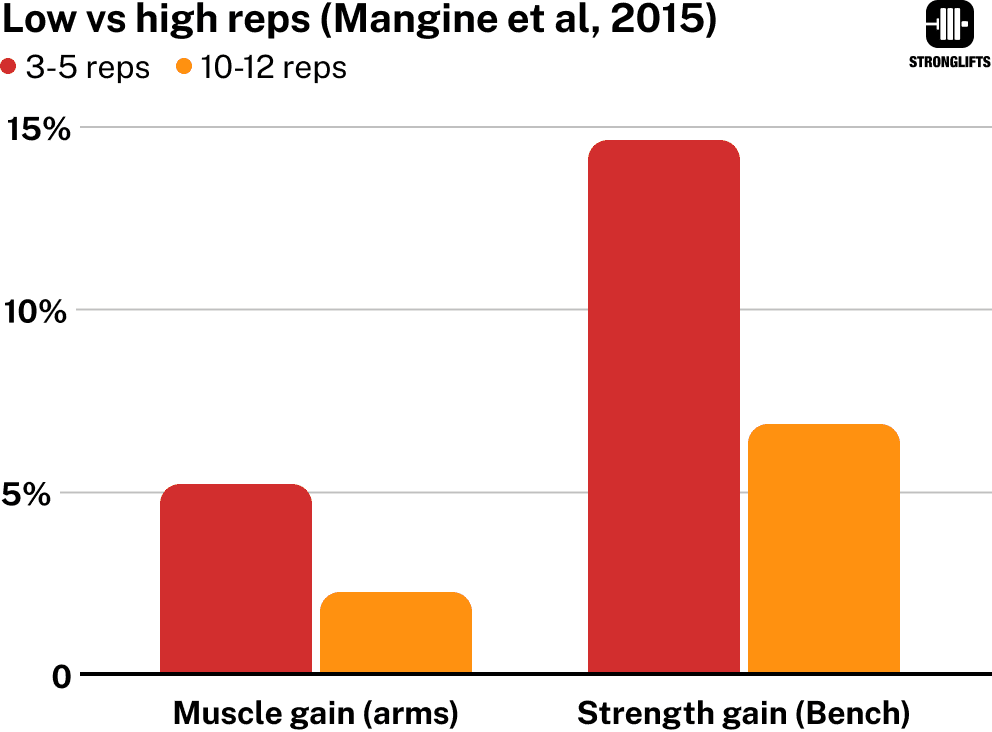
Schoenfeld et al compared 7 sets of 3 reps to 3 sets of 10 reps (11). No difference in muscle gains. The low rep group got stronger.
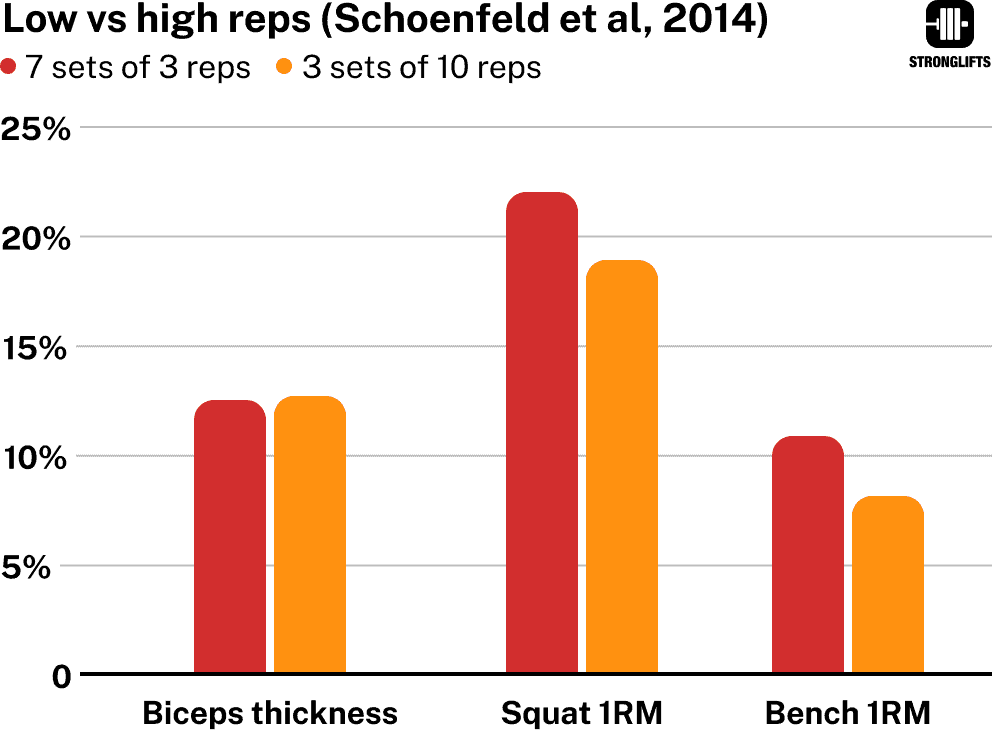
Campos et al compared 3-5 reps with 9-11 reps and 20-28 reps (12). 3-5 reps built as much muscle as high reps. It built more strength too.
Every rep range builds muscle. It’s the weekly volume that matters.
Note that Madcow 5×5 has a higher rep back off set every workout C.
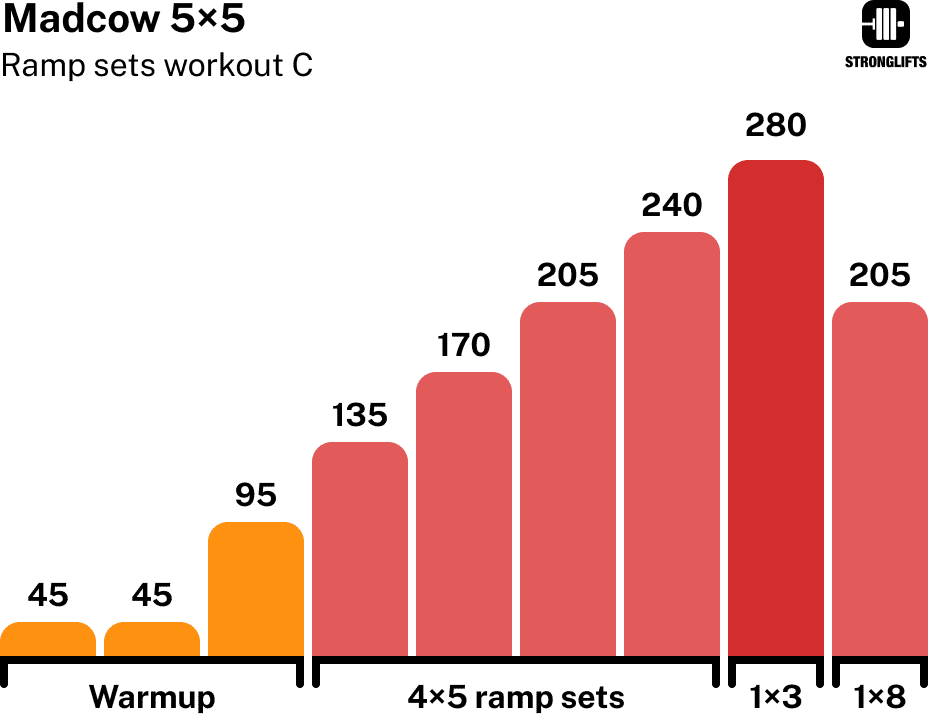
Some people say Madcow 5×5 doesn’t build muscle because it has no isolation for biceps. But several studies have found that adding isolation to a compound routine doesn’t grow the biceps more (13, 14, 15, 16 ).
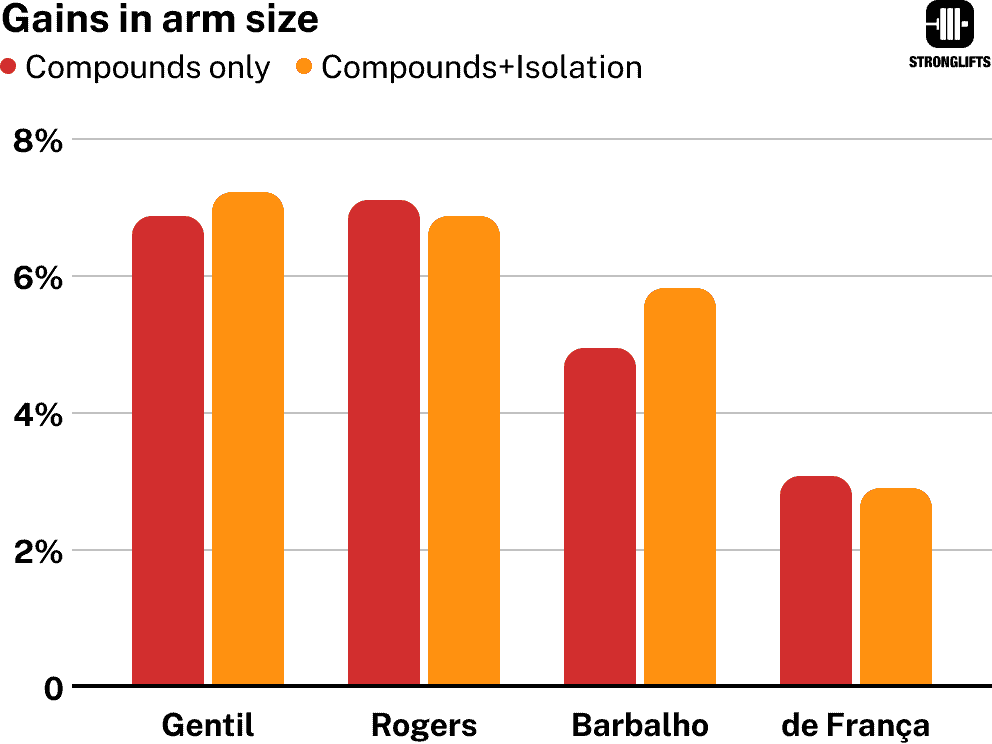
Maybe you like training arms. Maybe you think you benefit from it. If so, you can add high rep assistance work for arms.
| Workout A | Workout B | Workout C |
|---|---|---|
| Squat 5×5 | Squat 4×5 | Squat 4×5, 1×3, 1×8 |
| Bench 5×5 | Incline Bench 4×5 | Bench 4×5, 1×3, 1×8 |
| Rows 5×5 | Deadlift 4×5 | Rows 4×5, 1×3, 1×8 |
| Dips 3×8 | Barbell Curl 3×12 | Chinups 3×8 |
| Situp 3×12 | Planks 3×30sec | Skullcrushers 3×12 |
Madcow 5×5 started on bodybuilding forums 20 years ago. Madcow created this program for natural bodybuilders. It just happens to build strength too because it uses progressive overload.
Truth: Madcow 5×5 builds muscle. People who say five reps don’t build muscle aren’t up to date. Every rep range builds muscle given enough volume. There’s enough volume as shown in myth #1. Extra assistance exercises for smaller muscles can be added if you need that.
Read also
Myth 7: The assistance work is bad
Some people claim that the assistance work on Madcow 5×5 is terrible. They don’t like the extra exercises for the arms and abs.
The assistance work is an example. Madcow 5×5 was based on a program created by Bill Starr for Chris Mandrodt (17). He wrote…
The dips, bi’s and tri’s are what Bill called “Beach Work”…. The scheme for these varied by need and based on what I thought my weaknesses were. I went very heavy on the dips, for sets of 5, to help build up my triceps. Other guys did closegrips, or even added in some rowing movements for the lats.
Chris Manrodt
Many people don’t know how to program assistance work. Madcow 5×5’s standard assistance serves as a guide. It’s not set in stone.
Truth: the assistance work on Madcow 5×5 is optional and an example. You can skip it or do other exercises. Check the assistance work guide for ideas. People who complain about this are nitpicking.
Read also:
Myth 8: No individualization
Some people claim Madcow 5×5 ignores individual differences. They say everyone is forced to use the same progression rate and volume.
It’s the opposite. Madcow 5×5 offers you several ways to individualize your progression rate and volume…
- On-ramp period: you can change how many weeks it takes before you hit your previous best. Some prefer a longer on-ramp.
- Increments: you can add more or less weight each week. You can set a different progression rate on each exercise.
- Set intervals: you can dial the volume and intensity up or down to make your workouts harder or easier.
- Assistance work: you can add more exercises to target arms and abs or add volume for Bench and Deadlift.
Truth: Madcow 5×5 can be individualized to suit your needs and wants. You can change how fast you progress, how much volume you do, how hard each workout is, whether you target extra muscles, etc.
Myth 9: Workout B isn’t a light day
Some people claim Madcow 5×5 workout B isn’t a light day. They say the heavy Deadlifts will cause too much tiredness.
Comments like these show a misunderstanding of what a light day means. Light day doesn’t mean doing every exercise with light weights. Here’s why workout B of Madcow 5×5 is light…
- You Squat a lighter weight in workout B. You do this on purpose by not going as heavy as you do in workouts A/C.
- You use a harder Bench variation: the Incline Bench. The steeper bench angle forces you to use a lighter weight despite trying to lift heavy. You don’t hold back like on the Squats.
- You only do four sets per exercise in workout B. You do two less than in workout C and one less than in workout A.
This result is the lowest volume of the week in workout B. Workout A and C are higher in volume than workout B.

Notice how Madcow 5×5 has less sets in workout B than A/C.
| Workout A | Workout B | Workout C |
|---|---|---|
| Squat 5×5 | Squat 4×5 | Squat 4×5, 1×3, 1×8 |
| Bench 5×5 | Incline Bench 4×5 | Bench 4×5, 1×3, 1×8 |
| Rows 5×5 | Deadlift 4×5 | Rows 4×5, 1×3, 1×8 |
Here’s an example volume per workout including ramp and back off sets. I’ve only listed the top sets to keep the table simple.
| Workout A | Workout B | Workout C |
|---|---|---|
| Squat 5×280lb | Squat 5×210lb | Squat 3×285lb |
| Bench 5×180lb | Incline Bench 5×140lb | Bench 3×185lb |
| Row 5×160lb | Deadlift 5×330lb | Row 3×165b |
| 11650lb | 10525lb | 12625lb |
Workout B has the lightest Squat and Bench, and least sets. It’s lowest in volume despite the heavy Deadlifts. Workout B is the light day.
Some claim that doing Squats and Bench first in workout B will tire them out for Deadlifts. In find that hard to believe:
- Squats are light in workout B.
- Incline Bench doesn’t work muscles used for Deadlifts.
- On Stronglifts 5×5 you also did Squat, Overhead press, Deadlift in workout B. The Squats weren’t kept light.
If you can’t handle workout B, you need to go back to the basics. Go back to Stronglifts 5×5. Start with a light and easy weight. Do that for a couple of weeks before doing Madcow 5×5.
If Deadlifting after light Squats and Incline Bench is really an issue for you, flip it around. Deadlift first and finish with light Squats.
| Workout A | Workout B | Workout C |
|---|---|---|
| Squat 5×5 | Deadlift 4×5 | Squat 4×5, 1×3, 1×8 |
| Bench 5×5 | Incline Bench 4×5 | Bench 4×5, 1×3, 1×8 |
| Rows 5×5 | Squat 4×5 | Rows 4×5, 1×3, 1×8 |
You shouldn’t be struggling to complete your Deadlifts during the first four weeks of Madcow 5×5. That’s the easy on-ramp period.

If you’re struggling to complete your Deadlifts during the first four weeks, you started Madcow 5×5 too heavy. This is a common mistake. Lower the weight by about 20% and continue from there.
Truth: Madcow 5×5 workout B is a light day. It has the lightest Squats and Bench, the least sets and the lowest volume. If you struggle to complete your Deadlifts in week 1-4, you started too heavy. Note that this myth contradicts myth #2 claiming not enough Deadlifts.
Myth 10: Madcow 5×5 is too much volume
Some people claim Madcow 5×5 is too much volume. They think there’s too much Squatting and that 15 sets per week is excessive.
The most common mistake is starting the program too heavy. Madcow 5×5 starts with a four week on-ramp. You start light so your body can adapt to the Squat frequency and volume.

Volume is set × rep × weight. Starting with lighter weights on the Squat keeps the volume down during the first weeks.

Someone who starts Madcow 5×5 with a 315lb Squat will do 45% more volume per week than someone who starts with 200lb.
| Squats | 200lb Squatter | 315lb Squatter |
|---|---|---|
| Top set A | 5×200lb | 5×315lb |
| SQ Volume A | 3750lb | 5900lb |
| SQ Volume B | 2625lb | 4125lb |
| SQ Volume C | 4550lb | 7150lb |
| Total SQ volume | 10925lb | 17175lb |
Some people can Squat heavy despite not Squatting much in the past. If they start Madcow 5×5 too heavy, their body will have no time to adapt to the volume and frequency. This can result in aches & pains.
If this happens to you, back off the weight. Drop it by 20% or more. Let it be easy for about a month. This helps your body get used to the high Squat frequency and volume before you turn up the intensity.
What will also help is to add less weight on the bar each week (2.5-5lb vs 10-20lb). And use the default set intervals of 12.5%.
Truth: Madcow 5×5 is too much volume if you start the program too heavy or with a short on-ramp. Be cautious. The program looks easy but will challenge you. Note how this myth contradicts myth #1. It shows how the same volume can be low or high for different people.
Read also:
Join the Stronglifts community to get free access to all the spreadsheets for every Stronglifts program. You’ll also get daily email tips to stay motivated. Enter your email below to sign up today for free.
References
1. Ralston, Grant W et al. “The Effect of Weekly Set Volume on Strength Gain: A Meta-Analysis.” Sports medicine (Auckland, N.Z.) vol. 47,12 (2017): 2585-2601.
2. Schoenfeld, Brad J et al. “Dose-response relationship between weekly resistance training volume and increases in muscle mass: A systematic review and meta-analysis.” Journal of sports sciences vol. 35,11 (2017): 1073-1082.
3. Nigro, Federico, and Sandro Bartolomei. “A Comparison Between the Squat and the Deadlift for Lower Body Strength and Power Training.” Journal of human kinetics vol. 73 145-152. 21 Jul. 2020.
4. Travis, S Kyle et al. “Characterizing the Tapering Practices of United States and Canadian Raw Powerlifters.” Journal of strength and conditioning research vol. 35,Suppl 2 (2021): S26-S35.
5. Pritchard, Hayden J et al. “Tapering Practices of New Zealand’s Elite Raw Powerlifters.” Journal of strength and conditioning research vol. 30,7 (2016): 1796-804.
6. Kraemer, William J, and Nicholas A Ratamess. “Fundamentals of resistance training: progression and exercise prescription.” Medicine and science in sports and exercise vol. 36,4 (2004): 674-88.
7. Ralston, Grant W et al. “Weekly Training Frequency Effects on Strength Gain: A Meta-Analysis.” Sports medicine – open vol. 4,1 36. 3 Aug. 2018.
8. Schoenfeld, Brad Jon et al. “How many times per week should a muscle be trained to maximize muscle hypertrophy? A systematic review and meta-analysis of studies examining the effects of resistance training frequency.” Journal of sports sciences vol. 37,11 (2019): 1286-1295.
9. Kubo, Keitaro et al. “Effects of 4, 8, and 12 Repetition Maximum Resistance Training Protocols on Muscle Volume and Strength.” Journal of strength and conditioning research vol. 35,4 (2021): 879-885.
10. Mangine, Gerald T et al. “The effect of training volume and intensity on improvements in muscular strength and size in resistance-trained men.” Physiological reports vol. 3,8 (2015): e12472.
11. Schoenfeld, Brad J et al. “Effects of different volume-equated resistance training loading strategies on muscular adaptations in well-trained men.” Journal of strength and conditioning research vol. 28,10 (2014): 2909-18.
12. Campos, Gerson E R et al. “Muscular adaptations in response to three different resistance-training regimens: specificity of repetition maximum training zones.” European journal of applied physiology vol. 88,1-2 (2002): 50-60.
13. Gentil, Paulo et al. “Effect of adding single-joint exercises to a multi-joint exercise resistance-training program on strength and hypertrophy in untrained subjects.” Applied physiology, nutrition, and metabolism = Physiologie appliquee, nutrition et metabolisme vol. 38,3 (2013): 341-4.
14. Barbalho, Matheus et al. “Does the addition of single joint exercises to a resistance training program improve changes in performance and anthropometric measures in untrained men?.” European journal of translational myology vol. 28,4 7827. 2 Nov. 2018.
15. Rogers, R. A., et al. “The effect of supplemental isolated weight- training exercises on upper-arm size and upper-body strength.” NSCA Conference. 2000. https://paulogentil.com/pdf/The effect of supplemental isolated weight training exercises on upper arm size and upper body strength.pdf
16. de França, Henrique Silvestre et al. “The effects of adding single-joint exercises to a multi-joint exercise resistance training program on upper body muscle strength and size in trained men.” Applied physiology, nutrition, and metabolism = Physiologie appliquee, nutrition et metabolisme vol. 40,8 (2015): 822-6.
17. Manrodt, Chris. “New Lifter.” Strength Online, http://www.deepsquatter.com/strength/archives/manrodt4.htm.
